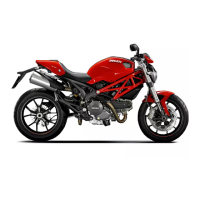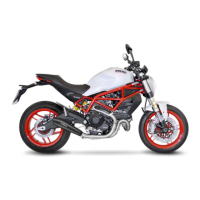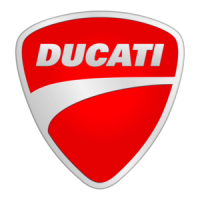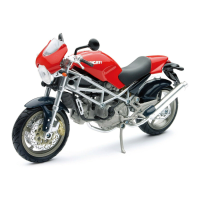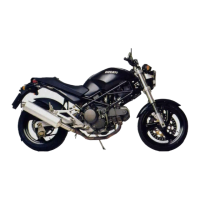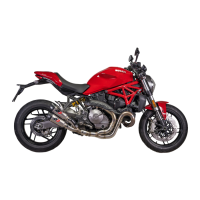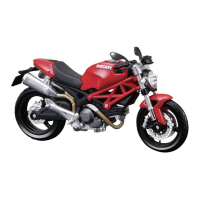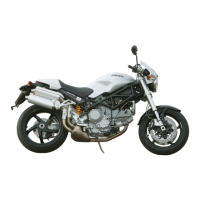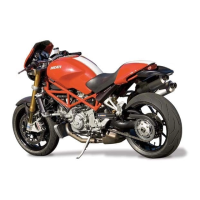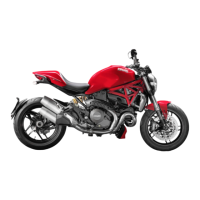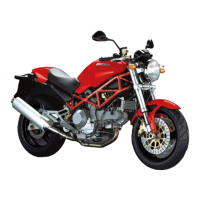Do you have a question about the Ducati Monster 795 and is the answer not in the manual?
Essential safety advice for riding, maintenance, and rider responsibilities.
Rider training, protective apparel, and safe riding operations.
Safe refuelling guidelines, fuel type, and maximum load capacity.
Overview of the instrument panel, its indicators, and warning lights.
Explanation of LCD display functions, parameters, and settings.
Details on speed, odometer, trip meter, and reserve fuel trip functions.
Information on clock, engine oil temp, service indicator, and battery voltage.
Using lap timer and activating the DDA data logger for performance analysis.
How the immobilizer system works, key codes, and override procedures.
Location and identification of all motorcycle controls, switches, and levers.
Operation of ignition, handlebar controls, pedals, and their adjustments.
Location of key components like seat lock, side stand, and shock absorbers.
Guidelines for the initial break-in period to ensure engine longevity.
Essential checks before riding and procedures for starting the engine.
Step-by-step guide for moving off and proper braking and parking methods.
Air filter, fluid levels, brake pads, chain, and battery maintenance.
Tyre pressure, repair, replacement, and wheel balancing.
Checking engine oil level, viscosity, and proper motorcycle cleaning methods.
Procedures for battery maintenance and charging during storage.
Dealer and customer scheduled maintenance tasks by mileage and time.
Weights, dimensions, engine, fuel system, brakes, and transmission details.
Overview of electrical components, lighting, and fuse box information.
Essential safety advice for riding, maintenance, and rider responsibilities.
Rider training, protective apparel, and safe riding operations.
Safe refuelling guidelines, fuel type, and maximum load capacity.
Overview of the instrument panel, its indicators, and warning lights.
Explanation of LCD display functions, parameters, and settings.
Details on speed, odometer, trip meter, and reserve fuel trip functions.
Information on clock, engine oil temp, service indicator, and battery voltage.
Using lap timer and activating the DDA data logger for performance analysis.
How the immobilizer system works, key codes, and override procedures.
Location and identification of all motorcycle controls, switches, and levers.
Operation of ignition, handlebar controls, pedals, and their adjustments.
Location of key components like seat lock, side stand, and shock absorbers.
Guidelines for the initial break-in period to ensure engine longevity.
Essential checks before riding and procedures for starting the engine.
Step-by-step guide for moving off and proper braking and parking methods.
Air filter, fluid levels, brake pads, chain, and battery maintenance.
Tyre pressure, repair, replacement, and wheel balancing.
Checking engine oil level, viscosity, and proper motorcycle cleaning methods.
Procedures for battery maintenance and charging during storage.
Dealer and customer scheduled maintenance tasks by mileage and time.
Weights, dimensions, engine, fuel system, brakes, and transmission details.
Overview of electrical components, lighting, and fuse box information.
| Displacement | 803 cc |
|---|---|
| Bore x Stroke | 88 mm x 66 mm |
| Compression Ratio | 11:1 |
| Power | 64 kW (87 hp) @ 8250 rpm |
| Fuel System | Electronic fuel injection, 45 mm throttle body |
| Exhaust | Lightweight 2-1-2 system with catalytic converter and twin lambda probes |
| Transmission | 6-speed |
| Frame | Tubular steel Trellis frame |
| Front Brake | 2 x 320 mm discs, 4-piston radial caliper |
| Rear Brake | 245 mm disc, 2-piston caliper |
| Front Tire | 120/70 ZR17 |
| Rear Tire | 180/55 ZR17 |
| Engine Type | L-Twin, Desmodromic distribution, air cooled |
| Torque | 78 Nm @ 6250 rpm |
| Front Suspension | 43 mm upside-down fork |
| Rear Suspension | Progressive linkage with preload and rebound Sachs adjustable monoshock |
| Fuel Tank Capacity | 15 L |
| Dry Weight | 167 kg |
| Seat Height | 770 mm (30.3 inches) |
